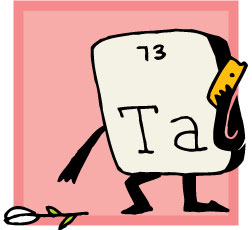Blogging the Periodic Table

Joseph Conrad once called the Congo "the vilest scramble for loot that ever disfigured the history of human conscience"—which, boy, is saying something. Unfortunately, we've had little reason to revise that assessment lately. There's a good chance that an element you're carrying around in your pocket right now helped escalate the horrific civil war in the Democratic Republic of Congo that has raged for a decade and a half now.
It all traces back to the expansion of modern electronics to all corners of the periodic table. According to a recent story in the Guardian, electronic chips in the 1980s used about a dozen elements. Today, that figure is closer to 60. One of those newly useful elements is tantalum, Element 73. Tantalum is dense, heat-resistant, and noncorrosive, and it holds a charge well—qualities that make it vital for cell phones. (Its cousin on the periodic table, niobium, also works, though not quite as well.) And as cell phone sales increased worldwide from practically zero in 1991 to 1 billion in 2001, the demand for tantalum skyrocketed, too.
This should have been a boon for Congo, which has 60 percent of the world's tantalum reserves, but the country was in chaos during that time. It sits next door to Rwanda, and one day in 1996 the ousted Rwandan government spilled into Congo seeking refuge. Their enemies pursued them. At the time, this seemed just to extend the Rwandan conflict a few miles west. In retrospect, this brush fire blew right into centuries of accumulated racial kindling. Tribes in Congo used the skirmishes that followed as an excuse to start attacking one another, and things escalated quickly. Eventually, nine countries and 200 ethnic tribes, each with its own ancient alliances and unsettled grudges, were warring in the jungles of Central Africa.
But the battles never would have gotten so intense without tantalum. Tantalum ore—especially a tantalum/niobium mineral called coltan—fetched around $200,000 per ton by the early 2000s, and buyers desperate to meet quotas often didn't bother inquiring about the source of the goods they were buying. And unlike other mineral wealth in the region (gold, diamonds), gathering tantalum required little more than a shovel and a sturdy back. It practically oozed out of the ground in local creeks and riverbeds, a thick gray mud easy to collect and transport. A farmer could earn 20 times what he did before by "mining" tantalum, and many Congolese soon abandoned their farms for prospecting, upsetting Congo's already shaky food supply. Most of the new miners didn't know what the tantalum was for, nor did they care. They knew only that Westerners paid a lot of money for it—and that they, the Congolese, could use the proceeds to buy guns or support local militias.
The result would have made Conrad blanch. Some incidents were merely sad—like the butchering of gorillas for meat by desperate citizens. Other events seem ripe for international war-crime investigations—like mass, tactical rape sprees.
The world demand for cell phones and tantalum obviously didn't cause the troubles in the Congo. Ethnic hatred did. It's clear, however, that the fire wouldn't have burned so hot without the influx of coltan cash. The war reached its height between about 1998 and 2001—at which point cell phone makers finally realized what was happening in the jungle. And to their credit, they banded together and began to buy tantalum and niobium from Australia, even though it cost more. Congo soon cooled down.
But despite an official truce ending the war in 2003, the war never really died in parts of the country. And lately, the high demand for another element used in consumer goods, tin, has begun to fund even more fighting. In all, more than 5 million people have died in Congo in a little more than 15 years, making it the most deadly war on earth since World War II. It's proof that, in addition to all the uplifting moments the periodic table has inspired, its valuable contents can also bring out humankind's worst, most inhuman instincts.
Like Slate on Facebook. Follow us on Twitter.